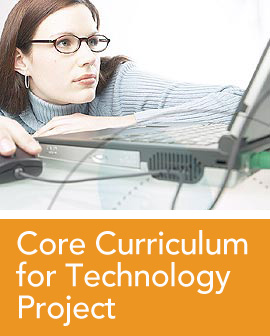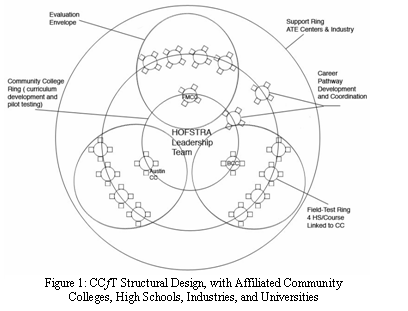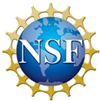

 New Engineering and Technology Text developed by the CCfT Project
New Engineering and Technology Text developed by the CCfT Project
Student Activity Guide (under Supplements)
Instructor's Resource (under Supplements)
Dr. David Burghardt,
Principal Investigator, Center for Technological Literacy
Phone: (516) 463-5550
E-mail
Web site
Dr. Michael Hacker,
co-Principal Investigator, Center for Technological Literacy
Phone: (516) 214-0241
E-mail Vitae Bio
For more information,
please contact:
Lois Miceli, STEM Administrator
Phone: (516) 463-6482
E-mail
Project Description
This materials development project includes three community colleges and two NSF-ATE Centers as partners. Four high schools are field-testing the materials. The project is designing, pilot testing, and disseminating a year-long technology course for high schools, including a textbook with content and student activities driven by the Standards for Technological Literacy in three content areas: physical technology, information technology, and technology in the living world. The materials are based on Understanding by Design (backwards design) and national standards, and implement inquiry, engineering design, and hands-on learning. The project deliverables include:
- A year-long high school technology course with a text and student workbook
- Teacher support materials
- Career development materials embedded within the text
- A media-rich Project website
- A cross-curricular integrative Fast Food facility design activity that contextualizes content in physical, information, and living world technology.
The materials are being disseminated through online sources and published by Thomson Delmar Learning. Grant Wiggins is a consultant to the project for materials design. A needs assessment for these materials has been done, which provides support for the project. Industry professionals and high school teachers are participating in the development teams.
Conceptual Design
CCfT will establish three ATE development sites, one each focused on the contexts of technology in the living world, information technology, and physical technology. CCfT Structural Design, with Affiliated Community Colleges, High Schools, Industries, and Universities Partner CCs and their affiliated high schools will bring, and further develop expertise in one of the technological contexts and serve as sites for curriculum development, pilot testing, and dissemination. Field testing will occur in four high schools associated with each development site. The CC co-PIs will provide conceptual leadership and direct development efforts within their sites coordinated through the Project director.
The Project will be organized in three rings, each representing responsibilities undertaken by institutions within it (development, field testing, and support-see figure 1). Emanating from the core will be the Project leadership and support structure, which will scaffold the work being accomplished by the curriculum development and pilot-testing teams from the three community colleges and their regional high school counterparts.
Field testing will occur in four high schools with support provided by the dedicated community college; for example, BCC, the college with information technology expertise, will identify, recruit, and support schools that will field-test the information technology materials. Formative and summative evaluation will be coordinated by the Project evaluator, Dr. Deborah Hecht of the Center for Advanced Study in Education at the City University of New York Graduate Center (see Research, Evaluation, and Dissemination section).

CCfT Work Plan and Timeline
The development cycle and work plan involves curriculum and student activity development, writing and pilot testing in year I; expert review and field testing in year II; and revision, publication, and dissemination in year III as shown below:
|
Year I - April 2006 to March 2007
|
||||
|
April to June 2006
|
July to September 2006
|
October to December 2006
|
January to March 2007
|
|
|
|
|
|
|
|
Year I I- April 2007 to March 2008
|
||||
|
April to June 2007
|
July to September 2007
|
October to December 2007
|
January to March 2008
|
|
|
|
|
|
|
|
Year III- April 2008 to March 2009
|
||||
|
April to June 2008
|
July to September 2008
|
October to December 2008
|
January to March 2009
|
|
|
|
|
|
|
Project Mission, Vision and Goals
The primary mission of the CCfT Project is to develop a series of high-quality, classroom-ready semester-long curriculum materials to introduce learners in grades 10-12 to contemporary technologies and STEM careers in physical technology, information technology, and technology in the living world. Through the efforts of the CCfT partners, we expect to:
- Produce, field-test, evaluate, and revise three comprehensive, semester-long cross-disciplinary courses for grades 10-12 that promote career exploration, are guided by STL, and are linked to skill and academic standards.
- Generate student and teacher interest and positive attitudes toward STEM careers.
- Develop teacher support materials that scaffold instruction in each of the courses.
- Build a collaborative team to provide pedagogical and content expertise during curriculum writing, and provide quality professional development to curriculum adopters.
- Enhance high school students' content knowledge and skills, as well as their ability to choose personally appropriate career pathways in Project-related STEM fields.
- Evaluate, commercially publish, and disseminate methods, materials, and results.
High School Textbook Table of Contents
Part One: Life in our Engineered World
Chapter 1: Engineering, Technology, Society, And Culture (Peruzzi)
- Section 1 - Characteristics and Scope of Engineering and Technology
- Section 2 - Technology and the Environment
- Section 3 - How Technology Influences History
- Section 4 - Engineering Problem Solving
Technology and People
Technology in the Real World
Engineering Quick Take
Summary
Key Terms
Feedback Questions
Career Opportunities in Engineering and Technology
Design Activities
Chapter 2: Informed Design (Burghardt, Hacker)
Introduction
Key Ideas
Chapter Sections
- Design, Modeling and Analysis
- Design Process Overview
- Further Considerations in Designing
- Ethics, Safety and Risk
Technology and People
Technology in the Real World
Engineering Quick Take
Summary
Key Terms
Feedback Questions
Informed Design in Engineering and Technical Careers
Design Activities
Chapter 3: Developing Abilities for a Technological World (Hacker)
Introduction
Key Ideas
Chapter Sections
- Applying the Design Process
- Using and Maintaining Products and Systems
- Assessing the Impact of Products and Systems
- Management of Technological Endeavors
Technology and People
Technology in the Real World
Engineering Quick Take
Summary
Key Terms
Feedback Questions
Matching Your Interests and Abilities with Career Opportunities
Design Activities
Part Two: The Designed World - Engineering and Technology in the Physical World
Chapter 4: Materials Processing (Hacker)
Introduction
Key Ideas
Chapter Sections
- Types of Materials
- Properties of Materials
- Processing Materials
- Factors in Selecting Materials
Technology and People
Technology in the Real World
Engineering Quick Tale
Summary
Key Terms
Feedback Questions
Career Opportunities in Materials Processing
Design Activities
Chapter 5: Manufacturing (Qaissaunee)
Introduction
Key Ideas
Chapter Sections
- Resources for Manufacturing Systems
- Durable and Non-durable Goods
- Processing Materials: Forming, Separating, Combining, and Conditioning
- Interchangeability of Parts
- Changes in Manufacturing Methods and Processes
- Automated Manufacturing
- Resources Needed for Manufacturing
- Assessing the Feasibility of Manufacturing a Product
Technology and People
Technology in the Real World
Engineering Quick Take
Summary
Key Terms
Feedback Questions
Career Opportunities in Manufacturing
Design Activities
Chapter 6: Construction (Hacker)
Introduction
Key Ideas
Chapter Sections
- Resources Needed for Construction
- Types of Structures
- Assessing the Feasibility of a Construction Project
- Site Design
- Architectural Design
- Green Design
Technology and People
Technology in the Real World Engineering Quick Take
Summary
Key Terms
Feedback Questions
Career Opportunities in Construction
Design Activities
Chapter 7: Energy and Power (Burghardt)
Introduction
Key Ideas
Chapter Sections
- Energy Forms
- Work, Heat, and Intrinsic Energy Forms
- Conservation of Energy
- Energy Sources
- Engines and Power Systems
Technology and People
Technology in the Real World
Engineering Quick Take
Summary
Key Terms
Feedback Questions
Career Opportunities in Energy and Power
Design Activities
Chapter 8: Transportation (Gordon)
Introduction
Key Ideas
Chapter Sections
- The World as a Global Village
- Transportation Resources
- Types of Transportation Systems
- Relationships between Transportation and Other Technologies
- Transportation Processes
- Efficiency
Technology and People
Technology in the Real World
Engineering Quick Take
Summary
Key Terms
Feedback Questions
Career Opportunities in Transportation
Part Three: Information and Communication Technology
Chapter 9: Electricity and Electronics (Prestopnik)
Introduction
Key Ideas
Chapter Sections
- Electricity Concepts
- Electrical Circuits
- Electronics
Technology and People
Technology in the Real World
Engineering Quick Take
Summary
Key Terms
Feedback Questions
Career Opportunities in Electricity and Electronics
Design Activities
Chapter 10: Computers and Computer Architecture (Prestopnik)
Introduction
Key Ideas
Chapter Sections
- Integrated Circuits
- Processors
- Computer Architecture
Technology and People
Technology in the Real World
Engineering Quick Take
Summary
Key Terms
Feedback Questions
Career Opportunities in Computer Design
Design Activities
Chapter 11: Modern Electronic Communication (Qaissaunee)
Introduction
Key Ideas
Chapter Sections
Technology and People
Technology in the Real World
Engineering Quick Take
Summary
Key Terms
Feedback Questions
Career Opportunities in Computer Technology
Design Activities
Chapter 12: Data Networking and Communication (Qaissaunee)
Introduction
Key Ideas
Chapter Sections
Technology and People Technology in the Real World
Engineering Quick Take
Summary
Key Terms
Feedback Questions
Career Opportunities in Electronic Information Systems
Design Activities
Part Four: Engineering and Technology in the Living World
Chapter 13: Biotechnology (Fletcher)
Key Ideas
Introduction
Chapter Sections
- The Changing World of Biotechnology
- The Biotech Workplace and Workforce
- Basic Knowledge and Skills for Biotechnology
Technology and People
Technology in the Real World
Engineering Quick Take
Summary
Key Terms
Feedback Questions
Career Opportunities in Biotechnology and Engineering
Design Activities
Chapter 14: Chemical Technology (Fletcher)
Introduction
Key Ideas
Chapter Sections
- Chemical Technology
- Biochemistry
Technology and People
Technology in the Real World
Engineering Quick Take
Summary
Key Terms
Feedback Questions
Career Opportunities in Chemical Engineering and Technology
Design Activities
Chapter 15: Agricultural Technology (Fletcher)
Introduction
Key Ideas
Chapter Sections
- Agriculture
- Food and Fiber Production
- Precision Agriculture
- Value Added Agriculture
Technology and People
Technology in the Real World
Engineering Quick Take
Summary
Key Terms
Feedback Questions
Career Opportunities in Agricultural Engineering and Technology
Design Activities
Chapter 16: Medical Technology (Fletcher)
Introduction
Key Ideas
Chapter Sections
- Medical technology
- Prevention and Rehabilitation
- Vaccines and Pharmaceuticals
- Medical and Surgical Procedures
- Telemedicine
Technology and People
Technology in the Real World
Engineering Quick Take
Summary
Key Terms
Feedback Questions
Career Opportunities in Medical Technology
Design Activities
Part Five: A Look Ahead
Chapter 17: (Gordon)
Introduction
Key Ideas
Technology in the Future
The Global World
Nanotechnology
Biotechnology
Information and Communications Technology
Future Technologies at Work
Technological Impacts
Technology and People
Technology in the Real World
Engineering Quick Take
Summary
Key Terms
Feedback Questions
Emerging Career Opportunities
Design Activities
Features of Textbook
Description
CCfT is developing a comprehensive text developed for use by Technology Education students in grades 9-12. The book is unique in that is has been developed by a writing team comprising nationally known leaders in engineering and technology with exceptional credentials and name recognition. These individuals include content specialists and educators who direct National NSF Centers in Information Technology and Biotechnology, the Hofstra University Center for Technological Literacy, and a NASA Center for Spatial Information Technology.
The text is explicitly driven by the national Standards for technological Literacy (STL) developed by the International Technology Education Association and validated by the National Academy of Engineering. Co-author Michael Hacker served as a member of the STL development team.
Woven throughout the text are passages that will acquaint students with the requirements, responsibilities, necessary personal attributes and attitudes, and educational pathways that will promote academic and career success in various technological areas. This science, technology, and engineering career development material is keyed to each chapter.
Outstanding Features
This text includes readings, student "informed design" activities, assessment items, ideas for further investigations, and a compelling set of design features in each chapter. These include (1) an Engineering Quick Take that presents chapter ideas within an engineering context and provides mathematical and scientific analyses that are appropriately grade-level related; (2) Technology and People that introduces the readers to charismatic women and men who have made meaningful and interesting technological contributions; (3) Technology in the Real World articles that showcase interesting innovations and trends, fun facts, extreme engineering, and socio-technological impacts; (4) Careers in Technology that are designed to encourage student to pursue further study leading to viable and promising careers in engineering and technology. The items are significant because they exemplify current "best practice" in text design and they allow learners to reach further than the printed page.
Pedagogy
The book will be underpinned by the most contemporary pedagogical practices. The American Association for the Advancement of Science (AAAS) Project 2061 Textbook Analysis Procedure has informed the development of this text and its ancillary materials. Following this procedure has ensured that the materials:
- Align content to important technological ideas (as defined by the standards)
- Provide a sense of purpose
- Take account of student ideas
- Engage students with relevant applications
- Develop and use technological ideas
- Promote students' thinking about technological impacts, experiences, and knowledge
- Assess progress formatively and summatively.
Informed Design Activities
The text and the accompanying Student Activity Guide (SAG) include a set of avant-garde design activities using an "informed design" pedagogy. This design pedagogy was developed and validated during the conduct of several large-scale National Science Foundation-funded technology education projects managed by co-authors Burghardt and Hacker. The procedure was created with knowledge gleaned from works in engineering, cognitive science, and human learning.
Informed design enables students to enhance their own related knowledge and skill base before attempting to develop design solutions. The procedure prompts research, inquiry, and analysis; fosters student and teacher discourse; and cultivates language proficiency. Student design teams will clarify specifications and constraints; conduct research; generate alternatives; justify the optimal design; test, evaluate, and modify the solution; and communicate achievements in a class presentation and final design report.
To provide the foundation for informed design activity, the student activities engage groups of learners in a progression of knowledge and skill builders (KSBs) - short, focused activities designed to teach salient concepts and skills. KSBs prepare students to approach the design challenge from a knowledgeable base and provide evidence for assessing understanding of important ideas and skills. As background for design activity, KSBs enable students to reach informed design solutions, as opposed to engaging in trial-and-error problem solving where conceptual closure is often not attained.
Coupled with the features previously mentioned, the Student Activity Guide allows students to be scaffolded through each of the activities. The SAG includes space for students to write about the design challenge; their research into design ideas; proposed solutions; pre-design tasks (Knowledge and Skill builder Activities); testing and analysis procedures: design modifications; and communicating their results.
Making a Stethoscope
This is a sample activity from the Engineering and Technology text that was a product of the NSF-funded CCfT Project.
Problem Situation:
A doctor uses a stethoscope to listen to the human heart. As the heart beats, it causes the stethoscope to vibrate. These vibrations are transmitted to the doctor's ears as sound. A simple acoustic stethoscope consists of several parts. A chest piece, which the doctor places against the patient's chest over the heart, vibrates with each heartbeat. The resulting acoustic waves travel through an air-filled tube that leads to a three-way junction that leads to two earpieces. The earpieces relay the acoustic waves into the doctor's ears. The doctor is then able to hear the characteristic "lup-dup" sound of the heart beating and so evaluate the patient's health.
Your Challenge:
You work in the risk management department of a large corporation. As part of the company's new safety regulations, each work area must have instructions for making basic medical equipment from everyday materials in case of dire emergency. You have been asked to come up with guidelines for creating a working stethoscope from common equipment.
Safety Considerations:
- The information provided is not medical advice and is not intended to diagnose or treat any health
conditions. Likewise, do not use the stethoscope you create to diagnose or treat any health conditions. - If you share a stethoscope with another person, clean the earpieces with rubbing alcohol before each use.
Material Needed:
- Plastic funnel or cut-off top portion of plastic water bottle
- Balloon
- Plastic, rubber, or silicone tubing, at least 24 inches long
- 3-way connector
- Tape
- Other commonly found materials
Clarify Design Specifications and Constraints:
You will make a functioning stethoscope using commonly found materials. It will consist of a chest piece with a diaphragm and at least one earpiece. The stethoscope must allow the user to clearly hear a human heartbeat when placed on a subject's upper left chest. It must work whether the subject is sitting, standing, or lying down, and the user must be able to count the subject's heartbeats. Your stethoscope should work as well as a commercially available acoustic stethoscope.
Research and Investigate:
To complete the design challenge, you need to first gather information to help you build a knowledge base.
- In your guide, complete the Knowledge and Skill Builder I: Acoustics.
- In your guide, complete the Knowledge and Skill Builder II: Cardiac auscultation.
- In your guide, complete the Knowledge and Skill Builder III: Heart rate.
Choose and Justify the Optimal Solution:
What decisions did you reach about the construction of a stethoscope? How did you reach these decisions?
Display Your Prototypes:
Produce your stethoscope. Include descriptions, photographs and/or drawing of it in your guide.
Test and Evaluate:
Explain whether your designs met the specifications and constraints. What tests did you conduct to verify this?
Redesign the Solution:
What problems did you encounter that would cause you to redesign the stethoscope? What changes would you recommend in your new design?
Communicate Your Achievements:
Describe the plan you will use to present your results to your class, and show what handouts you will use.
Project Management
CCfT brings together a highly regarded group of national STEM leaders with exceptional credentials and proven materials development and project management success.
Dr. David Burghardt, Project PI, is head of engineering and co-director of the Hofstra University Center for Technological Literacy (CTL). He has directed five NSF ATE, MSP, and TE projects, and will administer the budget and provide technical support to the writing teams.
Dr. Linnea Fletcher is the director of the South Central Region Bio-Link ATE Center at Austin CC and is one of the nation's foremost biotechnology educators. She has a rich content background in biotechnology and bioinformatics, has worked extensively with secondary school teachers, and has been a PI on NSF ATE projects. As co-PI, she will lead the biotechnology team.
Anthony Gordon is the Director of Technology for the Saginaw, Michigan Public Schools. Gordon developed an international reputation in Design and Technology while serving as the Technology Advisor for the Staffordshire, England Schools for many years. He is leading the development of the Transportation and Futures Sections of the text.
Michael Hacker co-directs the Hofstra CTL. He was formerly the NYSED state supervisor for technology education. He was a member of the STL writing team and co-managed the NYS MST standards development. He has co-directed six NSF ATE, IMD, MSP, and teacher enhancement projects. He will provide curriculum and pedagogical support to the writing teams.
Michael Qaissaunee is a co-PI at the NSF ATE National Center for Telecommunications Technology at Springfield Technical Community College. He is a recognized author of IT-based textual materials with expertise in wire line, wireless, and fiber-optic technologies. He will serve as a co-PI and lead the IT team.
Richard Prestopnik, professor of electrical and computer technology at Fulton-Montgomery Community College (FMCC), will serve as a Project co-PI and lead the physical technology team. Mr. Prestopnik, a team leader, principal writer, and curriculum content expert on the NSF NYSCATE project, developed and directed the NASA-funded Spatial Information Technology Center at FMCC and is an expert in digital and microprocessor systems.
Dr. William Peruzzi was a science supervisor, high school principal, and NYSED consultant. He was the coordinator of the NSF-funded NYSCATE Project that developed HS and CC ATE Curriculum materials. He is leading the development of the introductory chapters.

CCfT is funded by the National Science Foundation
(Grant DUE-0603403)